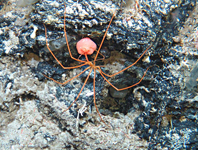Abstract
Cerambycidae is one of the largest families of beetles, containing about 38,000 described species (Tavakilian & Chevillotte 2018). In most species of this family, adults possess a stridulatory device that allows them to produce squeaking sounds (Wang 2017). In the subfamilies Prioninae and Parandrinae, individuals stridulate by rubbing their ridged hind femora against elytral margins (Švácha & Lawrence 2014). In the other subfamilies, including Lamiinae, the stridulation is produced by friction between the ventral face of the posterior pronotal margin (plectrum) and a striated plate on the mesoscutum (pars stridens) (Švácha & Lawrence 2014). Although some adults produce sounds during courtship and copulation, this sound production occurs mainly when individuals are disturbed, being considered a defensive mechanism that might act as a startle response against predators (Dumortier 1963; Švácha & Lawrence 2014; Wang 2017).
References
Alexander, R.D. (1957) Sound production and associated behavior in insects. The Ohio Journal of Science, 57, 101–113.
Alexander, R.D., Moore, T.E. & Woodruff, R.E. (1963) The evolutionary differentiation of stridulatory signals in beetles. Animal Behaviour, 11, 111–115.
https://doi.org/10.1016/0003-3472(63)90018-6
Bioacoustics Research Program (2014). Raven Pro: Interactive Sound Analysis Software (Version 1.5). Software. Available from: http://www.birds.cornell.edu/raven (accessed 21 November 2018)
Dumortier, B. (1963) Morphology of sound emission apparatus in Arthropoda. In: Busnel, R.G. (Ed.), Acoustic Behaviour of Animals. Elsevier, Amsterdam, pp. 277–345.
Finn, W.E., Mastro, V.C., & Payne, T.L. (1972) Stridulatory apparatus and analysis of the acoustics of four species of the subfamily Lamiinae (Coleoptera: Cerambycidae). Annals of Entomological Society of America, 65 (3), 644–647.
https://doi.org/10.1093/aesa/65.3.644
Gerhardt, H.C. & Huber, F. (2002) Acoustic Communication in Insects and Anurans: Common Problems and Diverse Solutions. The University of Chicago Press, Chicago and London, 531 pp.
Hernandez, J.M. (2007) Estridulación provocada por la interacción entre coespecíficos en la especie Iberodorcadion (Hispanodorcadion) perezi hispanicum (Mulsant, 1851) (Coleoptera, Cerambycidae, Lamiinae). Boletín de la Asociación Española de Entomología, 31 (3–4), 259–269.
Hernandez, J.M. (2011) Estructura del órgano estridulador y análisis de la emisión acústica de Agapanthia dahli (Richter, 1821) (Coleoptera, Cerambycidae, Lamiinae). Animal Biodiversity and conservation, 34, 257–264.
Hernandez, J.M., Garcia, D. & Gamarra, P. (1997) Comunicación acústica en algunas especies de Iberodorcadion Breuning, 1943 (Coleptera: Cerambycidae: Lamiinae). Elytron, 11, 51–61.
Švácha, P. & Lawrence, J.F. (2014) Cerambycidae Latreille, 1802. In: Leschen, R.A.B. & Beutel, R.G. (Eds.), Handbook of Zoology, Arthropoda Insecta. Coleoptera, Beetles, Morphology and Systematics. Volume 3. Walter de Gruyter GmbH, Berlin, pp. 77–177.
Tavakilian, G. & Chevillotte, H. (2018) Titan: base de données internationales sur les Cerambycidae ou Longicornes. Version 3.0. Available from: http://titan.gbif.fr/ (accessed 21 November 2018)
Wang, Q. (2017) Cerambycidae of the World. Biology and Pest Management. Taylor & Francis, Boca Raton, 628 pp.

